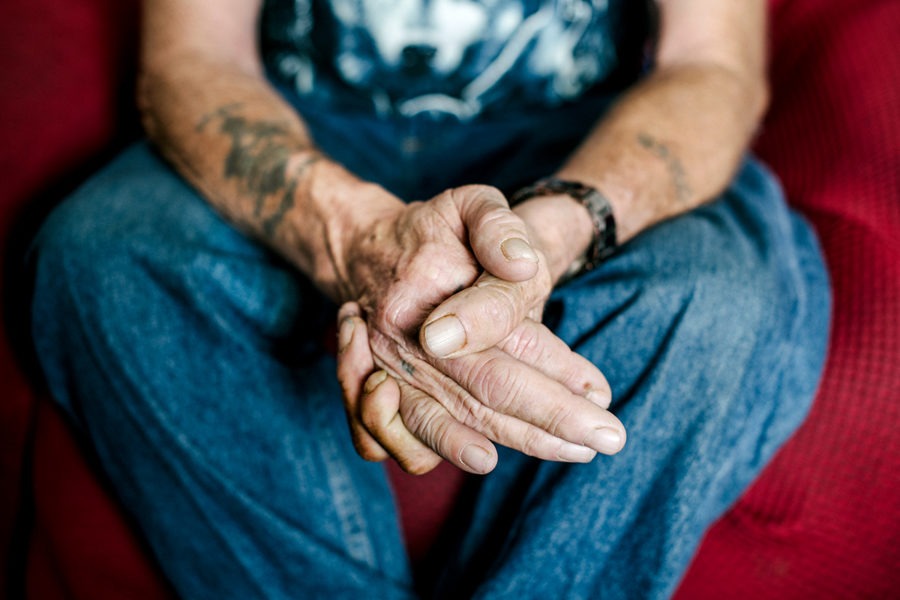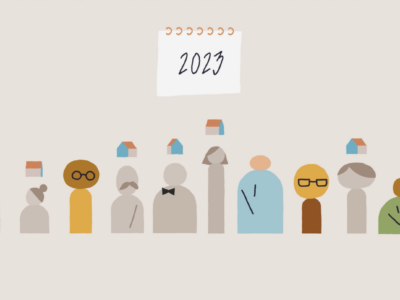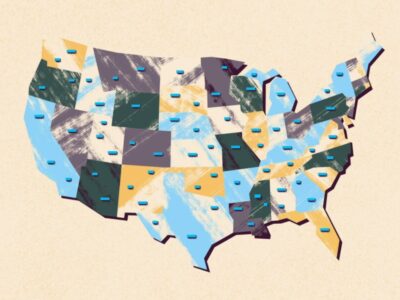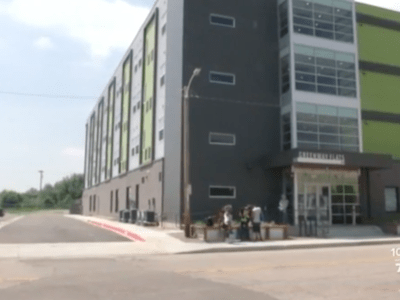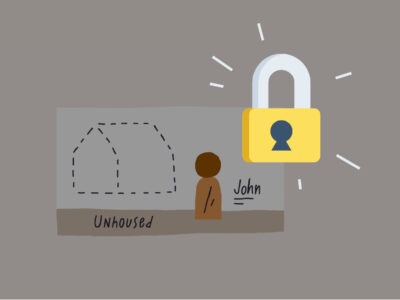Quick — how many people are experiencing homelessness in your city right now?
This isn’t a trick question. It’s fundamental to ending homelessness: your community must know who is experiencing homelessness in order to end it.
Built for Zero communities know how many people are experiencing homelessness at any time. But they know a lot more than that too. They know who each person is living without a home and what support they need to get back into housing. They know the length of time each person been homeless and what specific challenges are keeping them out of housing, like not having a driver’s license or birth certificate, for example.
They know all this with the help of something called a by-name list.
But this isn’t just about collecting stats on each person experiencing homelessness. Taken together, the by-name list data gives a view of homelessness across the entire community — and allows teams to work toward ending it.
What is a by-name list?
A by-name list is a comprehensive list of every person in a community experiencing homelessness, updated in real time. Using information collected and shared with their consent, each person on the list has a file that includes their name, homeless history, health, and housing needs.
“They’re not a number. They’re a community member.”
Patrick Dodds, Director of CoC
United Way of North Central Florida
By maintaining a by-name list, communities are able to track the ever changing size and composition of their homeless population. They know current and detailed information on every homeless person in a given subpopulation.
“A by-name list is exactly what it sounds like. It’s getting to know each person by name and creating that ownership and understanding in our community that this is a member of our community that we’re trying to help,” said Patrick Dodds, the Director of Continuum of Care (CoC) at United Way of North Central Florida. “And when you know them by name, you know them. They’re not a number. They’re a community member,”
Communities use by-name list data plotted in graphs to understand the impact of different ideas designed to reduce homelessness and see if these ideas work. Because they are constantly tracking who is experiencing homelessness in their community, they’re able to see if their interventions are working. And they’re able to tell quickly, allowing them to course correct if they aren’t seeing improvement.
What’s the difference between a by-name list and HMIS data?
A Homeless Management Information System (HMIS) is a database communities use to track how people experiencing homelessness interact with services. Communities incorporate this data into their by-name list.
By continually consolidating data from HMIS and local partners outside of the HUD-funded homeless-response system, plus constant outreach to individuals that might be disconnected from supportive services, communities have found it possible to identify everyone experiencing homelessness and support them from first contact all the way to achieving permanent stable housing. This continual, by-name approach gives all stakeholders a clear understanding of the community’s unique homelessness crisis in real time, allowing quicker case resolution for individuals and more efficient resource allocation across the community.
How do communities make sure they’ve accounted for every person experiencing homelessness?
Built for Zero communities work with coaches to help them develop quality data on their local homeless population.
We provide a scorecard that uses qualitative and quantitative data to ensure that communities have covered their full jurisdiction and that all homeless service providers are coordinating their efforts.
The scorecard assesses:
- community participation and coverage, ensuring that a community is capturing all adults experiencing homelessness, including people living without shelter, people living in shelters, people living in transitional housing, people without homes about to enter hospitals or jails, and people fleeing domestic violence
- policies and procedures, ensuring that communities have policies in place to accurately reflect people entering or exiting homelessness and to maintain timely and accurate data
- data infrastructure to track data points related to system-wide inflow and outflow, and ensuring that the by name list has the capacity to track critical population-based statuses in real time, including age, household size, chronic homeless status, and veteran status
Some communities start by creating a by-name list focused on a specific population, like single adults. Others create lists that account for all households experiencing homelessness in their community. The goal is that eventually communities will build one list accounting for all people experiencing homelessness.
How is this by-name list data used?
Once a community has established quality, system-wide data — data they can trust — on the homeless population, this is when the magic happens. They’re able to better match housing solutions with individuals, prioritize community resources, and track the state of homelessness in the community at large. This allows them to work effectively toward ending it.
On an individual level, by-name lists often form the basis for case conferencing meetings, where all the providers within a community meet to coordinate and drive forward with housing solutions for people.
On a systems level, teams use by-name list information represented in data visualizations to track homelessness across their entire community. Here, Co-Director of Built for Zero Beth Sandor shows data from Bakersfield, California, a community that has since ended chronic homelessness.
For example, in Lake County, Illinois, located north of Chicago, they noticed a strange pattern in their by-name list data. Veterans were living at one temporary housing provider for long periods of time. The team was surprised to learn that many of those veterans were not moving into permanent housing, because they needed to live at this facility to access dental care. In essence, veterans were remaining homeless in order to be able to go to the dentist. Once the team identified this issue, they found a way to fix it. Through this kind of continual problem-solving, informed by their by-name list, Lake County was able to end veteran homelessness in 2018.
How are the dynamics of homelessness measured and tracked?
The goal is to take the people on your by-name list and make sure each person gets connected to housing. So, we track how people move through the homeless response system. Everyone on the list is categorized according to where they are in the system.
Inflow: the new people
When a person loses housing and enters into homelessness, they’re part of what we call inflow. Inflow data points are:
- Newly identified: People new to homelessness
- Returned from housing: People who experienced homelessness before, got connected with housing, and now are homeless again
- Returned from Inactive: People who experienced homelessness before and exited to unknown destinations (left town, were institutionalized for 90+ days etc), and now are homeless again
Actively homeless: the people without housing right now
People who are currently homeless are categorized as:
- Actively homeless (in contrast to folks whose current status is Housed or Inactive)
Outflow: the people who are no longer homeless
Outflow data points are:
- Housing placements: People who are connected to permanent housing
- Moved to inactive: People who exit out of homelessness without support from the homeless response system, such as finding their own housing, moving out of the community, or entering a long-term stay in an institution
How often is the by-name list updated?
Monthly, at a minimum.
Do all cities use a by-name list?
No. But many communities, including more than 80 in Built for Zero, currently use a by-name list or are in the process of building one. Communities in Built for Zero make up roughly 20% of all Continuums of Care in the U.S.
Recognizing the necessary role that quality data plays in ending homelessness, other communities across the country are also using HMIS to collect, analyze, and use more dynamic data.
Is my city using a by-name list?
You can check to see if your city is part of Built for Zero, where they will build a by-name list of who is experiencing homelessness.
How is by-name list data different from the point-in-time count?
The U.S. Department of Housing and Urban Development (HUD) mandates an annual census of people experiencing homelessness, called the point-in-time count. By-name lists are updated more regularly to provide communities with more actionable information on homelessness.
Using the point in time count methodology is like taking a photo with an early model camera. The picture is distorted if the subject moves, and homelessness is always in flux, and the picture takes time to develop, in this case many months. The result is a hazy picture of the past.
What about privacy?
In most communities, anyone on the by-name list will sign a consent form that stipulates who their data can be shared with. Community teams decide who this data will be shared with, and in most communities, this data is only used to help people connect with safe and stable long-term housing.
Where did the idea of a by-name list come from?
In 2010, we launched an initiative to house 100,000 people experiencing chronic homelessness called the 100,000 Homes Campaign. Communities across the country beat this goal — they found permanent homes for more than 105,000 people in just four years.
While communities dramatically increased their housing placement rate (the number of people they could house a month), they didn’t dramatically reduce the number of people experiencing homelessness. We learned that in order to end homelessness, communities would need to count down to zero, rather than counting up to increase housing placements.
From there, we developed the idea of the by-name list to help communities account for everyone experiencing homelessness locally in partnership with local leaders in the field and federal partners at HUD and the VA.
So, what now?
Our field is moving to real-time, by-name data in so many places. Even communities outside of Built for Zero are working hard to improve the quality and comprehensiveness of their data in HMIS. It’s time for one, coordinated, federal approach that ends the unhelpful exercise of an annual snapshot and requires and supports every community in America to know everyone experiencing homelessness by name and in real time.
Learn what a Continuum of Care is, how it fits into the homeless response system — and how Built for Zero works with both.
